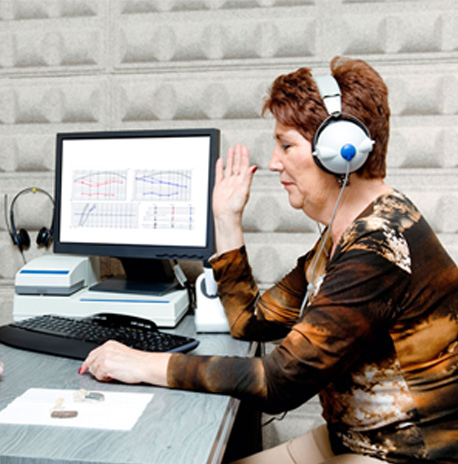AUDIOMETRY: HOW TO CHECK
What is Audiometry and Why is Hearing Testing Needed
Audiometry is a modern method of hearing diagnostics that allows assessing sensitivity to sounds of different frequencies and volumes. The procedure helps identify hearing impairments at an early stage and prevent their progression.
Regular hearing testing is essential for maintaining ear health, especially for people exposed to noise or working in unfavorable acoustic conditions. Audiometry for adults or children allows timely detection of hearing loss and selecting the optimal treatment.
Using audiometry, specialists obtain accurate data on the functioning of the inner ear and auditory nerve. This is important for proper diagnosis and subsequent hearing correction with hearing aids or other methods.
Audiometry also allows comparing results with previous tests and tracking changes in hearing, which is particularly important for people with chronic conditions or age-related changes.
Stages of Audiometry: Preparation and Procedure
The hearing test procedure begins with preparing the patient and explaining how the test will be conducted. It is important for the patient to be in a comfortable environment and understand the specialist’s instructions. Proper preparation for audiometry reduces the likelihood of errors in the test results.
The stages of audiometry include several sequential steps:
-
Assessment of overall hearing condition;
-
Equipment adjustment to individual parameters;
-
Conducting the test with different sound frequencies and volumes;
-
Recording results and preliminary analysis.
Advantages and Features of Audiometry
After audiometry, the specialist analyzes the obtained data and provides recommendations. Key advantages of the procedure include:
-
Ability to accurately diagnose hearing;
-
Determination of optimal hearing correction methods;
-
Possibility to monitor changes over time;
-
Minimal strain on the patient, including children.
Hearing testing helps detect not only hearing loss but also potential inner ear pathologies. Audiometry for children is especially useful for early detection of problems and timely selection of corrective measures.
The hearing test procedure is conducted using modern equipment that provides detailed audiometry results. This data serves as the basis for selecting a hearing aid or other hearing improvement methods.
How to Interpret Results and What to Do Next
After the test is completed, the specialist provides a breakdown of the audiometry results. It shows the level of sensitivity to sounds of different frequencies and helps determine whether further examination is needed.
Audiometry results serve as a guide for further action: hearing correction, selection of hearing aids, or monitoring changes over time. The Center for Hearing provides a full range of services for hearing diagnostics and improvement.
It is important to follow the specialist’s recommendations to maintain ear health and prevent further hearing deterioration. In case of detected impairments, regular tests, physiotherapy, or the use of hearing aids may be prescribed.
Regular audiometry helps people of all ages monitor their hearing condition. Audiometry for adults or children allows timely response to changes and ensures comfortable sound perception in daily life.

















